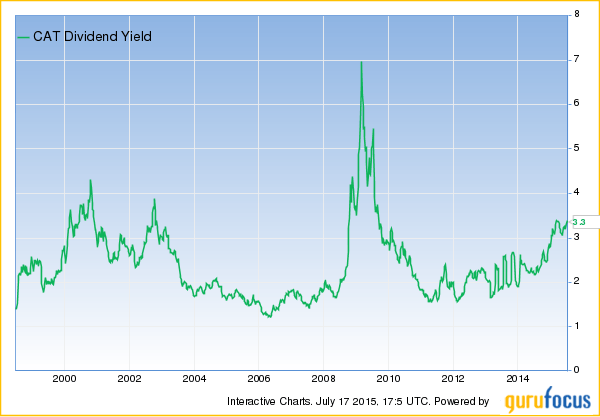The construction industry is cyclical. You may think the industry would not produce any consistent dividend stocks, but that’s not the case.
Caterpillar (NYSE:CAT) has been paying dividends since 1925. The company has not reduced its dividend payments since 1982.
Caterpillar (CAT) is the construction equipment manufacturing industry leader. The company has grown to reach a market cap of $50.6 billion.
As a large cap stock, Caterpillar divides its operations into 5 smaller segments. Each of the company’s 5 segments is listed below along with the percentage of total operating profits generated in Caterpillar’s most recent quarter.
- Construction Industries generated 33% of total operating income
- Resource Industries generated 4% of total operating income
- Energy & Transportation generated 44% of total operating income
- All Other Manufacturing generated 10% of total operating income
- Financial Products generated 10% of total operating income
The construction and energy/transportation segments together account for 77% of Caterpillar’s operating income. These segments are by far the most important for the company.
Caterpillar’s Growth
Caterpillar operates in several highly cyclical industries. As a result, the company’s earnings fluctuate wildly from year to year. This makes it impractical to judge the company on growth in any one year.
To gauge Caterpillar’s growth, I took the company’s average earnings from 2005 through 2009 and compared them to average earnings from 2010 through 2014. Using this ‘smoothing’ technique, Caterpillar has grown earnings-per-share at 9% a year over the last decade.
The company has grown its dividend payments even faster. Dividends per share have compounded at 12.2% a year over the last decade.
Caterpillar is currently in a ‘down’ phase. The company’s expected earnings-per-share in 2015 are forecasted to be down 46% versus all time earnings-per-share highs set in 2012. Nevertheless, the company’s long-term growth prospects remain bright.
Caterpillar is the global leader in the construction and earthmoving equipment industry. The company’s earnings are tied to commodity prices. When oil, gas, metal, and mineral prices are high, the company sees massive profits. When commodity prices fall (as has happened recently), the company’s earnings fall. With that said, Caterpillar’s long-term trend earnings trend is upward.
As the global population continues to rise, more construction occurs, and more commodities are needed. Caterpillar’s equipment is needed for construction and earthmoving. The company’s long-term growth drivers remain.
Valuation of Caterpillar Stock
Caterpillar’s wildly fluctuating earnings make using the price-to-earnings ratio a fool’s errand for valuing the stock.
Caterpillar’s dividend payments are remarkably stable, however. Caterpillar’s dividend yield is a good way to identify when is a good time to buy into the stock. The chart below shows Caterpillar’s dividend yield over the last 15 years:

As you can see, Caterpillar’s yield is higher than it has been since the Great Recession of 2007 to 2009 – when the yield absolutely sky-rocketed. Now is the best time in the last 5 years to buy Caterpillar stock based on its dividend yield.
Is Caterpillar Stock Safe?
Despite Caterpillar’s fluctuating earnings, the company remains profitable. Caterpillar still managed to make $895 million in net profit in 2009, during the depths of the Great Recession.
Caterpillar’s earnings-per-share through the Great Recession and subsequent recovery are shown below to give greater insight into the company’s earnings during serious economic downturns:
- 2007 earnings-per-share of $5.32
- 2008 earnings-per-share of $5.71
- 2009 earnings-per-share of $1.43
- 2010 earnings-per-share of $4.15
- 2011 earnings-per-share of $7.81
Caterpillar carries a significant amount of debt on its books. The company currently has $38.8 billion in debt with an interest coverage ratio of 5.9x. In addition, the company’s pension is underfunded. Caterpillar has $17.4 billion in pension assets, but pension obligations of $21.1 billion.
The combination of high debt and an underfunded pension with irregular earnings is not good for safety. I would rather see a highly cyclical business carry less debt than Caterpillar.
With that said, the company is in no danger of bankruptcy. Interest expense (excluding the company’s financing segment) was $129 million in Caterpillar’s most recent quarter, while operating profit was $1,527 million. The company would have to face a financial crisis significantly worse than the Great Recession to be in any real danger from its debt. The company is safe, but not as safe as many other, more conservatively financed businesses in less cyclical industries.
Final Thoughts
Caterpillar ranks in the top 20% of stocks with 25+ years of dividend payments without a reduction. The company’s solid earnings-per-share growth over the last decade combined with an attractive valuation bodes well for shareholders.
In addition, Caterpillar offers investors a dividend yield of 3.7%. The company has total return potential well over 10% from its dividend and future growth prospects.
Caterpillar stock is not for the faint of heart. The company’s stock has a standard deviation of 33.5% and a beta of 1.2. Caterpillar stock is more volatile than average. The stock is more volatile than average because of its dependence upon commodity prices. Caterpillar makes a good buy for dividend growth investors looking for high yields who are able to withstand volatility.
